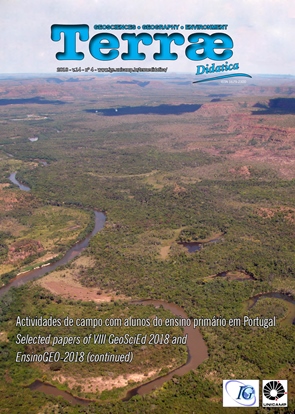Resumo
The aim of paleontology is the understanding of the life history on Earth, its development and processes along the geologic time. Hence, it involves diversified fields, being the micropaleontology one of them, whose focus lies on taxonomy and appli-cations. The micropaleontology is, sometimes, poorly developed in an institution due to the scarcity of specialists. In order to fill this gap, a didactic collection was prepared to facilitate the divulgation of the micropaleontology in the university. Due to the necessity of increase in the knowledge on microfossils among graduate and undergraduate students, an extension project of mi-crofossils didactic collection was carried out at the Geology Department of the Universidade Federal de Pernambuco. For each fossil group (i.e. ostracods, foraminifers, calcareous nannofossils, charophytes, radiolarians, diatoms, conodonts, palyno-morphs, fish fragments, echinoid spines, sponge spicules and mollusks) micropaleontological slides were assembled. The origin of the material is varied, with specimens from several Brazilian sedimentary basins and even from other countries. The collections consist in numbered and identified slides, besides the material necessary for their manipulation, such as brushes and spare slides. In each fossil group, the specimens are organized according to the morphology, taxonomy and age. Each slide has instructions for classes inserted in a Guidebook of Micropaleontology thoroughly illustrated, with general characteristics of each fossil group and the respective methodology for sample preparation. The collection is intended to be used in practical classes, workshops and short-courses, with biological, petrographic and stereoscopic microscopes, for observation of the mor-phological structures, identification and solution of problems proposed in the guidebook. Besides the improvement in the pale-ontology teaching, these collections will also contribute to the qualification of the students as future professionals.Referências
Bergqvist L.P., Prestes S.B.S. 2014. Kit paleontológico: um material didático com abordagem investigativa. Ciência & Educação, 20(2):345-357.
Cervato C., Frodeman R. 2013. A importância do tempo geológico: desdobramentos culturais, educacionais e econômicos. Trad. Briani M.C., Gonçalves P.W. Terræ Didatica, 10(1):67-79. URL: http://www.ige.unicamp.br/terraedidatica/v10_1/6.html. Acesso 25.10.2017.
Cruz S.F.C.F., Bosetti E.P. 2007. A geografia e a paleontologia: perspectivas de inter-relações no ensino fundamental., Ponta Grossa, Revista Terr@ Plural, 1(2):129-138.
Piovesan E.K., Melo R.M., Pedrosa F.A., Gomes C.R., Barros C.L. 2017. Coleção Didática de Microfósseis do Departamento de Geologia. UFPE. In: Simpósio de Geologia do Nordeste. 27. Resumos... João Pessoa-PB. URL: http://www.geologiadonordeste.com.br/busca/index.php?idCat=11#datas-importantes. Acesso 03.02.2018.
Zômpero A.F., Laburú C.E. 2011. Atividades investigativas no ensino de ciências: aspectos históricos e diferentes abordagens. Belo Horizonte, Ensaio, 13(3):67-80.
A Terrae Didatica utiliza a licença do Creative Commons (CC), preservando assim, a integridade dos artigos em ambiente de acesso aberto, em que:
- A publicação se reserva o direito de efetuar, nos originais, alterações de ordem normativa, ortográfica e gramatical, com vistas a manter o padrão culto da língua, respeitando, porém, o estilo dos autores;
- Os originais não serão devolvidos aos autores;
- Os autores mantêm os direitos totais sobre seus trabalhos publicados na Terrae Didatica, ficando sua reimpressão total ou parcial, depósito ou republicação sujeita à indicação de primeira publicação na revista, por meio da licença CC-BY;
- Deve ser consignada a fonte de publicação original;
- As opiniões emitidas pelos autores dos artigos são de sua exclusiva responsabilidade.

